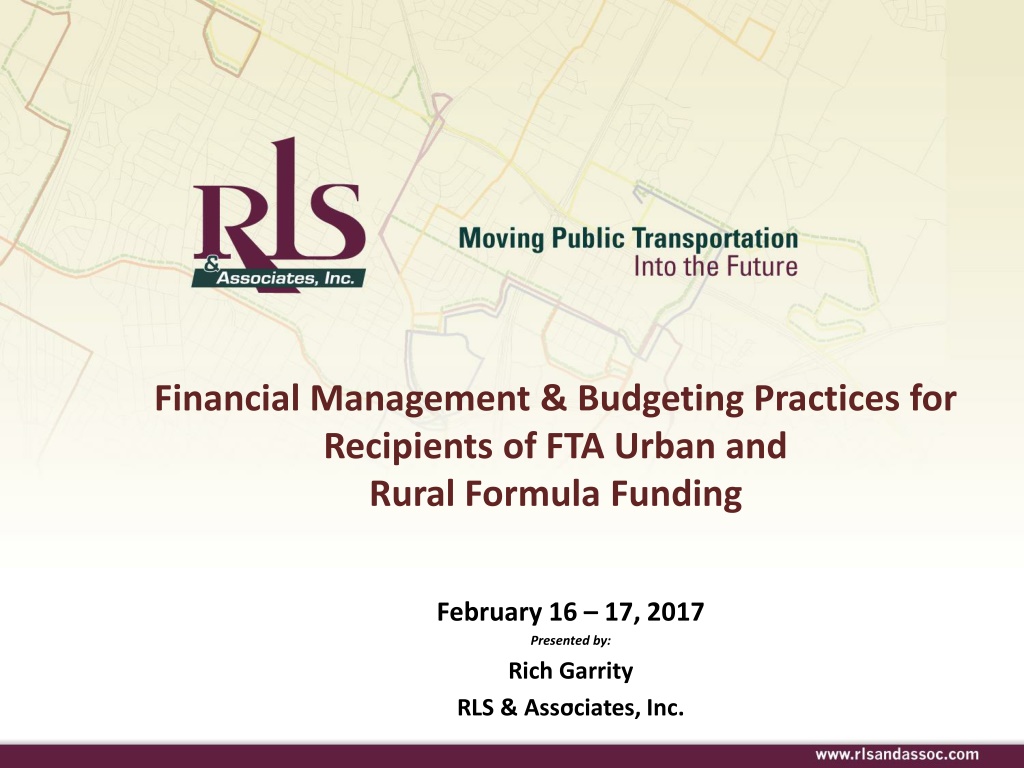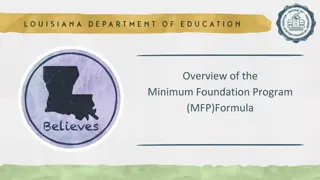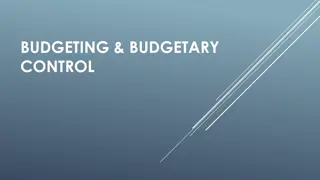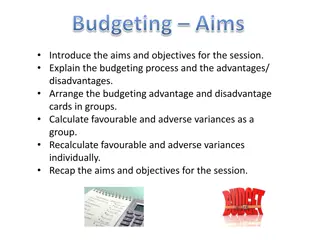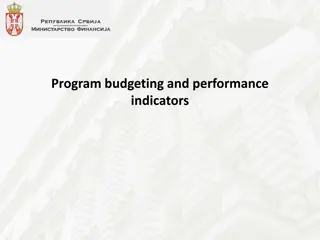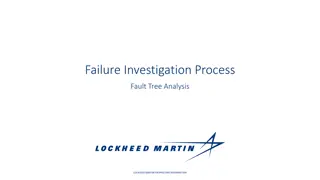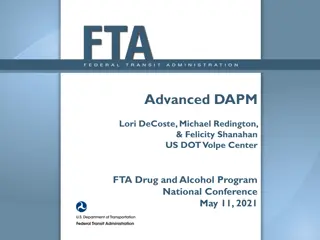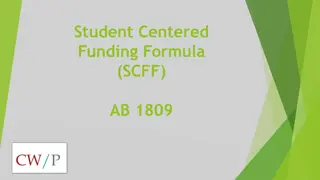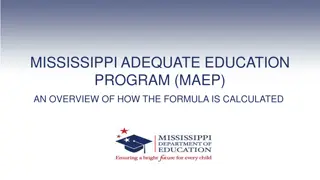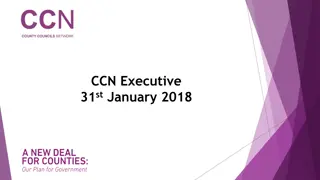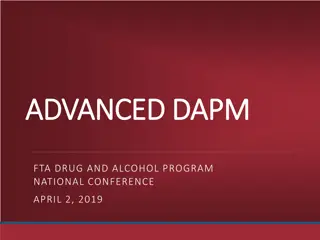Financial Management & Budgeting Practices for FTA Formula Funding
Explore essential financial management and budgeting practices for recipients of FTA Urban and Rural Formula Funding. Topics include basic requirements, NTD guidance, Super Circular requirements, FTA requirements in the new circular, basic budgeting methods, and cost allocation considerations. Gain insights on allocating costs to both urban and rural programs and understand FTA's expectations for reasonable cost allocation methodologies.
Download Presentation

Please find below an Image/Link to download the presentation.
The content on the website is provided AS IS for your information and personal use only. It may not be sold, licensed, or shared on other websites without obtaining consent from the author. Download presentation by click this link. If you encounter any issues during the download, it is possible that the publisher has removed the file from their server.
E N D
Presentation Transcript
Financial Management & Budgeting Practices for Recipients of FTA Urban and Rural Formula Funding February 16 17, 2017 Presented by: Rich Garrity RLS & Associates, Inc. .
Workshop Content Day 1 1 Basic Requirements 2 NTD Guidance 3 Super Circular Requirements 4 FTA Requirements in New Circular 5 Other Considerations 6 Basic Budgeting Methods 7 Cost Allocation 2 of 170
Module 1 BASIC REQUIREMENTS
Background on the Problem Recipients May Receive Funding Under the Formula Grants for Rural Areas (49 U.S.C. 5311) and the Urbanized Area Formula Program (49 U.S.C. 5307) Not Uncommon More Than 200 Entities Receive Funding Under Both Programs 4 of 170
Background on the Problem When an Entity Receives Funding Under Both Programs, It is Necessary to Allocate Eligible Costs to Both Programs Historically, FTA Has Provided Little Guidance on How to Do Such Allocations Requirement is Based on FTA Circular 9040.1G 5 of 170
Background on the Problem Because of the Wide Range of Circumstances Under Which an Operator May Provide Services in Both Urbanized and Rural Areas, FTA Expects the Subrecipient to Develop a Reasonable Basis Related to the Service Provided For Allocating Operating Costs Between the Two FTA Funding Sources The Subrecipient Should Also Apply This Procedure to Joint Capital Projects 6 of 170
Background on the Problem When There is a Question As to the Reasonableness of the Subrecipient s Cost Allocation Methodology, FTA Looks to the State to Make a Determination Hence, NCDOT is Providing Technical Assistance and This Training Workshop to Address This Issue 7 of 170
Module 2 FTA REQUIREMENTS REGARDING ALLOCATION OF COSTS IN URBAN & RURAL FORMULA PROGRAMS
NTD Guidance In This Module, We Will Extract Information, Guidance, and Suggestions From the 205-Page NTD Manual to Determine What Elements Will Have Impact on Allocation Methods 9 of 170
NTD Guidance NTD Requirements The NTD Requires Agencies to Report Most Data By Mode and Type of Service Typical Modes for Transit Systems in NC Commuter Bus (CB) Bus (MB) Demand Response (DR) Demand Response Taxi (DT) Trolleybus (TB) Vanpool (VP) 10 of 170
NTD Guidance NTD Requirements The NTD Requires Agencies to Report Most Data By Mode and Type of Service Types of Service Directly Operated Purchased Transportation 11 of 170
NTD Guidance NTD Requirements Transit Agencies Must Report Financial Data in a Uniform Manner in Conformance With Accrual Accounting and the Uniform System of Accounts (USOA) If Using Cash Basis, Transit Systems Must Re-State Their Financial Position When Reporting in NTD 12 of 170
NTD Guidance NTD Requirements Transit Agencies Must Report All Costs Related to Their Services Additionally, Agencies Must Accurately Report Direct Costs Transit Agencies May Allocate Indirect/Shared Costs to Each Mode and Type of Service 13 of 170
NTD Guidance NTD Requirements Service Area One Urban Area Rural Allocation Required If a Single Recipient Serves Two or More Urbanized Areas Urbanized Area and a Rural Area 14 of 170
NTD Guidance NTD Requirements We May Be Confronted with Operational Issues in Attempts to Segregate How To Assign Service to Areas For Example, a Transit System Originates a Trip in the Rural Area and Transports that Individual to an Urbanized Area How are the Direct Costs Associated with This Trip Get Assigned by Urban or Rural Area? 15 of 170
NTD Guidance Consider Smith County Collinsville UZA How Do We Allocate This Trip? Slide 100 Slide 100 16 of 170
NTD Guidance NTD Requirements If The Transit Agency Determines That the Intent of the Transit Service is To Serve the Travel Needs of All or Some of the Urbanized and Rural Areas in Which It Operates, Then the Transit Agency Allocates Its Federal Funding Data to the Urbanized and Rural Areas It Serves Using a Reasonable and Consistent Method 17 of 170
NTD Guidance NTD Requirements Agencies May Allocate Costs in a Variety of Ways Neither FTA Nor NCDOT is Prescriptive Common Allocation Variables Include Revenue Hours And Miles Vehicles Operated in Maximum Service (VOMS) Number of Employees Direct Expenses Ridership (Unlinked Passenger Trips) 18 of 170
NTD Guidance NTD Requirements Reporters Must Take Special Care to Ensure that They Allocate Indirect Expenses to Both Purchased Transportation and Directly-Operated Services Manual Provides Examples for Allocating Individual Object of Expenditures However, This is Not Good Practice and is Designed When an Entity s Shared Expense Are Limited 19 of 170
NTD Guidance NTD Requirements Potential Need to Allocation Fare Revenues as Well IF There Is a Fixed Fare for the Initial Segment of a Multi- Mode Trip and the Transfer Charge is Not Equal to the Fare Charged for a Single Ride Trip on the Next Mode A Large Portion of Passengers Use Prepaid Fare Media That is Accepted on all Modes 20 of 170
NTD Guidance NTD Requirements Farebox Revenue Allocation Typical Allocation Variables Unlinked Passenger Trips Passenger Miles Traveled Operating Expenses 21 of 170
NTD Guidance NCDOT S Goal To Provide a Reasonable and Consistent Method of Allocating Costs (and Revenues, if Necessary) to the Urban Formula and Rural Formula Programs Federal Operating Assistance Federal Capital Assistance What About Section 5311 Administration? 22 of 170
Chart of Accounts Considerations FTA Perspective FTA Recognizes Only Capital and Operating Costs The Allowance of Project Administration as An Eighty (80%) Cost is a State Option NCDOT Has Always Elected to Implement This Option This Creates Accounting Challenges for Entities That Receive Both Section 5307 and Section 5311 Funding 23 of 170
FTA/NTD Guidance FTA Perspective Transit Agencies May Use the Following Methods to Allocate Federal Funding Data Among Multiple Urbanized and Rural Areas Actual Data Vehicle Revenue Miles, or Other Notice the Use of May FTA Provides Guidance, But is Not Prescriptive 24 of 170
FTA/NTD Guidance FTA Perspective Actual Method Transit Agencies Use the Actual Data Method When They Directly Record the Values For Each Data Item by Urbanized and Rural Areas Transit Agencies Typically Use This Approach for Modes Such as Demand Response and Demand Response Taxi That Use Detailed Recording Systems FTA Means: Service Modes as Treated as their Own Fund in the Accounting System 25 of 170
Summary Expense Must be Reported by Mode Expenses Must be Reported by Type Expenses Must be Reported on the Accrual Basis An Entity s Indirect Costs Must be Reported 26 of 170
Summary If an Agency Serves More than One Urbanized Area or an Urbanized Area and a Rural Area, Expenses Must be Allocated Between Programs Expenses Must be Allocated Between Modes Agency Must Use a Reasonable and Consistent in Allocation Potential Need to Allocate Revenues 27 of 170
Summary The Only Real Practical Guidance on Allocation is Found in NTD Guidance Indeed, It is NTD and PTD Reporting Requirements That Will Dictate Local Practice in the Areas: Chart of Accounts Structure Accounting Budgeting Allocation Methods To Be Addressed in this Workshop 28 of 170
Summary Local Government (NFE) Urban State Grants NFE Indirect Costs NFE Central Services Costs Urban Federal Grants Cost Mode of Service Allocation Urban State Grants Transit Department Type of Service Urban Federal Grants Ineligible Costs Transit Operations Transit Capital Service Area (Rural and Urbanized Areas) Vehicle Maintenance Facility Maintenance General Administration Operations 29 of 170
Summary In Addition to These Issues, There are Basic Financial Management Issues That Must be Addressed in Order to Ensure a Fully Compliant Financial System 30 of 170
Module 3 SUPER CIRCULAR REQUIREMENTS FOR FINANCIAL MANAGEMENT
2 CFR Part 200.302(a) Financial Management Systems, Including Records Documenting Compliance With Federal Statutes, Regulations, and the Terms and Conditions of the Federal Award, Must be Maintained Records Must be Sufficient to Permit the Preparation of Reports Required By General and Program-Specific Terms and Conditions of the Grant Award Records Must Permit the Tracing of Funds to a Level of Expenditures Adequate to Establish That Such Funds Have Been Used According to the Federal Statutes, Regulations, and the Terms and Conditions of the Federal Award 32 of 170
2 CFR Part 200.302(b)(1) Identification, In Its Accounts, of All Federal Awards Received and Expended and the Federal Programs Under Which They Were Received Federal Program and Federal Award Identification Must Include, as Applicable, the CFDA Title and Number, Federal Award Identification Number and Year, Name of The Federal Agency, and Name of the Pass-Through Entity, If Any 33 of 170
2 CFR Part 200.302(b)(2) Accurate, Current, and Complete Disclosure of the Financial Results of Each Federal Award or Program in Accordance With the Reporting Requirements Set Forth in 200.327 34 of 170
2 CFR Part 200.302(b)(3) Records That Identify Adequately the Source and Application of Funds for Federally- Funded Activities These Records Must Contain Information Pertaining to Federal Awards Authorizations Obligations Unobligated Balances Assets, Expenditures, Income and Interest 35 of 170
2 CFR Part 200.302(b)(4) Effective Control Over, and Accountability for, All Funds, Property, and Other Assets The Non-Federal Entity Must Adequately Safeguard All Assets and Assure That They are Used Solely for Authorized Purposes 36 of 170
2 CFR Part 200.302(b)(5) Comparison of Expenditures With Budget Amounts for Each Federal Award 37 of 170
2 CFR Part 200.302(b)(5) Other Super Circular Requirements of Financial Management Systems Internal Controls Payments Cost Sharing/Local Match Program Income Revision to Grant Budgets 38 of 170
Module 4 FTA REQUIREMENTS IN NEW AWARD MANAGEMENT CIRCULAR
FTA Circular 5010.1F Issued on January 13, 2017, Effective on February 13, 2017 Key Themes in Management Timeliness/Accuracy of Federal Financial Reports (FFRs)/Milestone Progress Reports (MPRs) Accuracy of ALI Classification 40 of 170
FTA Circular 5010.1F Key Themes in Management Record Retention Applies to All Financial and Programmatic Records, Supporting Documents, Statistical Records, and Other Records of Each Recipient Records Retention and Access Requirements Also Apply to the Recipient s Third-party Contractors, Third-Party Subcontractors, and Subrecipients 41 of 170
FTA Circular 5010.1F Financial Management System Internal Control Compliance Requirements for the Federal Award Integration with Other Management Activities Delineation of Objectives Objectives Reasonable Assurance That Internal Controls are an Integral Part of the Recipient s Management Systems Existence of a Positive and Supportive Attitude Among the Recipient s Managers and Employees; Assignment of Internal Control Functions to Competent and Experienced Employees 42 of 170
FTA Circular 5010.1F Financial Management System Internal Control Objectives (Continued) Identification of Specific Internal Control Objectives to Ensure That Needs are Identified and That Valid Controls are Planned and Implemented Adoption of Internal Control Policies, Plans, and Procedures That Reasonably Ensure Their Effectiveness Organizational Separation of Duties Physical Arrangements, Such As Locks, Safes, and Fire Alarms Regular Program of Testing to Identify Vulnerabilities in the Internal Control System 43 of 170
FTA Circular 5010.1F Financial Management System Internal Control Guidance in the Green Book 44 of 170
FTA Circular 5010.1F Financial Management System Elements of the Financial Management System Financial Reporting Accounting Records Internal Control Budget Control Allowable Cost Determination Source Documentation Cash Management 45 of 170
Summary Subpart E Budget Management Cost Receivable Management Management Financial System Management Payment Management Fund Balance Management General Ledger Management 46 of 170
Financial Reporting Financial Management System Financial Reporting Accurate, Current, and Complete Disclosure of the Financial Results of Federally Assisted Activities Must Be Made In Accordance With Financial Reporting Requirements FFRs/NTD/OpStats 47 of 170
Accounting Records Financial Management System Accounting Records Recipients and Subrecipients Must Maintain Records That Adequately Identify the Source and Application of Funds Provided For Federally Assisted Activities These Records Must Contain Information Pertaining to the Award Authorizations Obligations 48 of 170
Accounting Records Financial Management System Accounting Records (Continued) Assets Liabilities Outlays or Expenditures Income Unobligated Balances 49 of 170
Internal Control Financial Management System Internal Control Effective Control and Accountability Must Be Maintained for All Cash Provided to Support the Award or Subaward Real and Personal Property Other Assets Recipients and Subrecipients Must Adequately Safeguard All Such Property and Must Ensure That It Is Used Solely for Authorized Purposes 50 of 170
